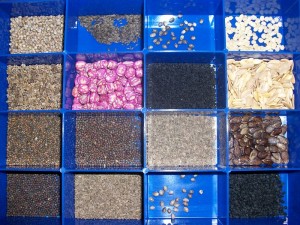 Saving seeds from your garden is a great way to insure that you have a great supply of seeds for next year. But… how do you do it?
Saving seeds from your garden is a great way to insure that you have a great supply of seeds for next year. But… how do you do it?
Note- It is very important that the vegetables be mature before you harvest them for seeds. I know the 2 foot zucchini tastes bland, but you can’t get good seeds from the little ones. Also, be sure the seeds are coming from vegetables and fruits that are non-GMO! These won’t reproduce… if you are unsure about what kind of seeds you have start with the Back40 Essential Seed Vault for best results.
Seeds basically come in two types… dry and wet. Each needs to be saved or prepared for storage in a slightly different way. Also, keep in mind that some vegetables, like carrots, and fruits will only produce seeds after two seasons.
Dry seeds are easier. When some plants go to seed they produce pods that contain seeds. These should be harvested when they are dry and starting to burst. Do this only on a warm, sunny day. Cut the pods off of the plant with a few inches of stem. Tie the stems together, maybe slide them into a large envelope or pillow case, and hang upside down for a few weeks until they dry out completely and release the seeds. Don’t put several types of seed pods together in one bunch, you won’t be able to sort out or identify them after they’ve gotten mixed up! Some seeds may need to be removed from the chaff… just rub lightly. Then store.
Wet seeds take a bit more effort. Tomatoes, pumpkins and squash have seeds that are encased in fleshy goo. In order to collect the seeds you need to wash the pulp away. I find that putting the mucky seeds in a strainer or colander, then rinsing them while lightly rubbing works well. When the seeds are clean, lay them out in a single layer on a plate or tray to dry. (Seeds will stick to paper). Shift them around from time to time to keep them from rotting or sticking. When they have dried completely, store them.
Make sure to LABEL your seed packet. You might include a few notes about the plants as a reminder for next season (no, you won’t remember). Store the packets or containers in a cool dry place… and you are ready to go for next year!
For more information about saving seeds, take a look at the book “Seed Swap” by Josie Jeffery.
Saving Seeds









1 pings
[…] Continue reading » […]